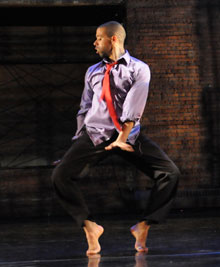
WHERE’S THE HUB? Beyond its title, Leichter’s The Whiz: Beantown didn’t exhibit any Boston-specific traits. |
Except for an impressive list of sponsors and presenters, Nicholas Leichter doesn't tell us much about The Whiz, his gloss on Sidney Lumet's 1978 movie The Wiz, a gloss on the 1939 movie The Wizard of Oz, which could be the most beloved and riffed-upon artifact of American culture.
The Whiz: Beantown, given courtesy of CRASHarts at the Institute of Contemporary Arts two weekends back, seems to be a floating entity, a composite of numbers that originated in a cabaret a year or so ago, accumulated more material, premiered in New York as a 90-minute dance work last June, and for all I know hasn't been seen in toto since. If you try to research The Whiz, you find it's morphed and shrunk to suit various performing venues, with subtitles attached to different versions — The Whiz: Obamaland, The Whiz: Moneyapolis. . . But the Beantown version didn't demonstrate that Leichter at some time or other had actually choreographed a dance or a show with a line of its own. And beyond the title, it didn't exhibit any Boston-specific traits.
The Whiz: Beantown and the other work on the ICA program, Killa (2009), both turned out to be sets of high-powered dance numbers strung together revue fashion, with recognition elements supplied by their iconic musical forerunners. Extraordinary costumes, wigs, props, and characters mentioned in accounts of previous performances didn't make it up the Northeast Corridor with the dancers.
I admit I never saw The Wiz on stage or screen, and I can't quote chapter and verse on Michael Jackson, Diana Ross, or any of the other culture signifiers embedded in Leichter's vocabulary. But the teenagers sitting next to me a week ago Friday night didn't seem overly engaged either. I think Leichter didn't take his material beyond the superficial reference points — bits of costume, musical moods and lyrics, crotch grabbing and moonwalking. And even these melted after the audience's first gasp.
Both dances relied heavily on the bizarre presence of Monstah Black, a "self-shaped Messiah of the Funk." Black, an apparition in a silver leather jacket with grandiose fur epaulets, coyly brandished a pink pistol as he slunk along the wall and down the steps onto the stage. From then on, in a variety of outré outfits, he minced around and among the dancers.
This epicene creature had a fairly small repertory of drag-queen antics — the leering looks, the mincing step, the swishy hips. He also sang and rapped along with tracks drawn from TheWiz, M.I.A., and Basement Jaxx. The music seems to have been modified so his voice could override the original artists. I began to think of him as a latter-day Sportin' Life, offering the temptations of a transgressive lifestyle. But his allure didn't make an impression on the eight other members of the company, who seemed more invested in showing off a conventional sexuality.
The dance movement constituted a mix of break and hip-hop acrobatics, contemporary-dance action, club dance, and a few low-key send-ups of ballet exercises. Aaron Draper did a solo in boxing gloves. Three men wrangled together, tumbling, lifting, supporting, dropping one another; they could have been pals or rivals, a team or trio of strangers.
Leichter did some rapping himself at the beginning of The Whiz, wearing a tiny skirt over his trousers. I guess ambiguity was the idea, because after a show of transgressive bravado during which he threw his wallet, his phone, and various other accessories on the floor, he considerately picked up the litter before he left so it wouldn't get in the way of the other dancers.